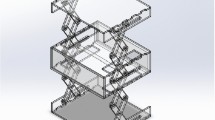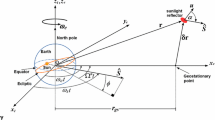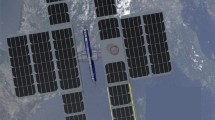Abstract
The Chandrayaan-1 mission proposes to put a 550 kg lunarcraft into Geostationary Transfer Orbit (GTO) using the Polar Satellite Launch Vehicle (PSLV) which will subsequently be transferred into a 100 km circular lunar polar orbit for imaging purposes. In this paper, we describe certain aspects of mission strategies which will allow optimum power generation and imaging of the lunar surface.
The lunar orbit considered is circular and polar and therefore nearly perpendicular to the ecliptic plane. Unlike an Earth orbiting remote sensing satellite, the orbit plane of lunar orbiter is inertially fixed as a consequence of the very small oblateness of the Moon. The Earth rotates around the Sun once a year, resulting in an apparent motion of Sun around this orbit in a year. Two extreme situations can be identified concerning the solar illumination of the lunar orbit, noon/midnight orbit, where the Sun vector is parallel to the spacecraft orbit plane and dawn/dusk orbit, where the Sun vector is perpendicular to the spacecraft orbit plane. This scenario directly affects the solar panel configuration. In case the solar panels are not canted, during the noon/midnight orbit, 100% power is generated, whereas during the dawn/dusk orbit, zero power is generated. Hence for optimum power generation, canting of the panels is essential. Detailed analysis was carried out to fix optimum canting and also determine a strategy to maintain optimum power generation throughout the year. The analysis led to the strategy of 180‡ yaw rotation at noon/midnight orbits and flipping the solar panel by 180‡ at dawn/dusk orbits. This also resulted in the negative pitch face of the lunarcraft to be an anti-sun panel, which is very useful for thermal design, and further to meet cooling requirements of the spectrometers.
In principle the Moon’s surface can be imaged in 28 days, because the orbit chosen and the payload swath provide adequate overlap. However, in reality it is not possible to complete the imaging in 28 days due to various mission constraints like maximum duration of imaging allowed keeping in view the SSR sizing and payloads data input rate, time required for downlinking the payload data, data compression requirements and visibility of the lunarcraft for the Bangalore DSN. In each cycle, all the latitudes are swept. Due to the constraints mentioned, only 60‡ latitude arc coverage is possible in each orbit. As Bangalore DSN is the only station, half of the orbits in a day are not available. The longitudinal gaps because of non-visibility are covered in the next cycle by Bangalore DSN. Hence, in the firstprime imaging season, only 25% of the prime imaging zones are covered, and an additional threeprime imaging seasons are required for a full coverage of the Moon in two years. Strategy is also planned to cover X-ray payload coverage considering swath and orbit shift.
Similar content being viewed by others
References
Bhandari N 2005 Chandrayaan-1: Science goals; This proceedings.
Bhardwaj Anilet al 2005 Low energy neutral atom imag- ing on the Moon with the SARA instrument aboard Chandrayaan-1 mission; This proceedings.
Goswami J Net al 2005 High Energy X-γ ray Spectro- meter on the Chandrayaan-1 Mission to the Moon; This proceedings.
Kamalakar J A, Bhaskar K V S, Laxmi Prasad A S, Ranjith R, Lohar K A, Venkateswaran R and Alex T K 2005 Lunar ranging instrument for Chandrayaan-1 (this proceedings).
Kiran Kumar A S and Roy Choudhury A 2005a Hyper- spectral imager in visible and near infrared band for lunar compositional mapping; This proceedings.
Kiran Kumar A S and Roy Choudhury A 2005b Terrain mapping camera for Chandrayaan-1; This proceedings.
Author information
Authors and Affiliations
Rights and permissions
About this article
Cite this article
Krishna, A., Gopinath, N.S., Hegde, N.S. et al. Imaging and power generation strategies for chandrayaan-1. J Earth Syst Sci 114, 739–748 (2005). https://doi.org/10.1007/BF02715959
Issue Date:
DOI: https://doi.org/10.1007/BF02715959




